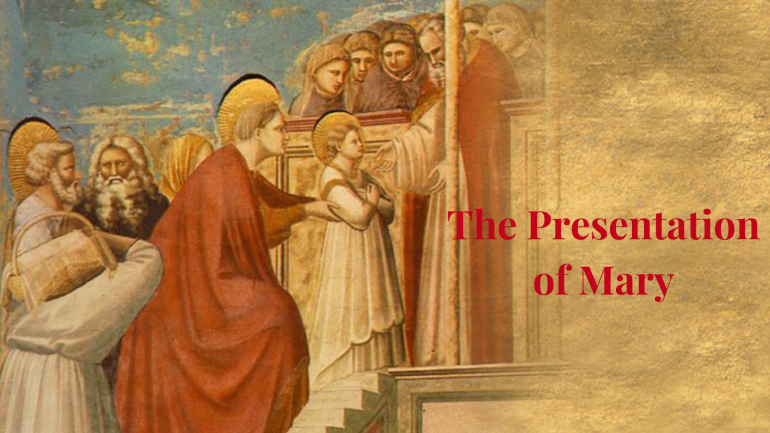The Presentation of Mary: The Dawn of a Divine Journey

Celebrated annually on November 21, the Feast of the Presentation of the Blessed Virgin Mary honours a profound moment in Christian tradition, the solemn dedication of the young Mary to God.
This sacred event, in which her parents, Saints Joachim and Anne, presented her in the Temple of Jerusalem, is not recorded in the canonical Gospels but lives vividly in the treasures of early Christian tradition. Its most detailed account appears in the Protoevangelium of James, a revered second-century text that offers a tender glimpse into Mary’s early life and her parents’ steadfast faith.
According to this tradition, Joachim and Anne, long barren yet steadfast in prayer, were blessed at last with a daughter through divine promise. Overcome with gratitude, they vowed to consecrate this precious child entirely to the service of God. In fulfilment of that vow, they brought Mary to the Temple while she was still a small child, a gesture far deeper than a customary offering. It was an act of pure thanksgiving and profound devotion, rooted in ancient Jewish custom yet radiant with prophetic meaning.
By dedicating her to the Lord, they declared that Mary belonged wholly to God from the very beginning, a foreshadowing of her future as the Mother of the Incarnate Word.
The New Eve and Salvation History
This feast reveals the very foundation of her spiritual identity, a life wholly centered on the will of God. Her early dedication in the Temple prefigures the moment of her perfect surrender at the Annunciation, when she would utter her timeless fiat: “Let it be done to me according to your word.” From the very beginning, Mary’s life was marked by an interior readiness to embrace the divine purpose, preparing her for her unique vocation as the Mother of God (Theotokos).
This feast also highlights Mary’s pivotal role in salvation history as the New Eve. Through her steadfast obedience and unwavering faith, first symbolised in her Presentation and later fulfilled throughout her earthly life, she reverses the disobedience of the first woman. Where Eve turned away from God, Mary turned wholly toward Him; where Eve’s choice brought separation, Mary’s fidelity opened the way to redemption. Her life, characterised by humility, purity, and trust, stands as a radiant model of total surrender, ushering in the dawn of humanity’s salvation.
A Foreshadowing of the Immaculate Conception
The Presentation of the Blessed Virgin Mary is profoundly linked to the doctrine of the Immaculate Conception. From the very moment of her existence, Mary was preserved from original sin and filled with divine grace, chosen to be the spotless vessel through whom God would enter the world. Her presentation in the Temple, therefore, is more than a ritual act; it is the outward manifestation of an inner reality, the visible sign of her lifelong holiness. In Mary, the true dwelling place of God takes human form; her very being becomes the living temple prepared to receive the Divine Word.

History and Evolution of the Feast
The Feast of the Presentation of the Blessed Virgin Mary traces its origins to the Eastern Church, where deep devotion to every moment of Mary’s life took root in the early centuries of Christianity.
By the sixth century, the celebration was firmly established in Jerusalem, inspired by the dedication of the Church of Saint Mary the New, erected by Emperor Justinian I near the Temple Mount. This sacred edifice stood as a visible sign of the mystery it commemorated: the young Mary’s solemn entrance into the Temple, proclaiming her total consecration to God.
From the East, this venerable devotion gradually made its way westward, finding a warm welcome in the Latin Church. By the fourteenth century, the feast had become part of the Western liturgical calendar, officially introduced in 1372 by Pope Gregory XI in Avignon. Though briefly suppressed during the reforms of Pope Pius V in the sixteenth century, its enduring spiritual significance led to its restoration by Pope Sixtus V in 1585, ensuring its permanent place in the Church’s worship and devotion.
A Model for Christian Discipleship
Devotion to the Presentation of Mary offers a profound model for Christian life, inviting the faithful to reflect on her virtues of openness to God, purity of heart, and joyful service. The feast reminds believers that holiness is not achieved in grand gestures but through a continual act of self-offering, a daily ‘yes’ to God’s will.
Just as the young Mary was consecrated to God in the Temple, every Christian is called to consecrate the ordinary moments of life to divine purpose. True spiritual growth, as Mary’s example teaches, unfolds through constancy, humility, and faithful devotion.
Living the Spirit of the Presentation
The enduring spirit of dedication embodied in Mary’s Presentation has borne abundant fruit in the life of the Church. Numerous religious congregations, particularly those devoted to education, contemplation, and compassionate service, have drawn their inspiration from this feast.
Among them, the Presentation Sisters, founded by Nano Nagle, stand as radiant witnesses to Mary’s spirit of consecration. In their commitment to teaching the young, uplifting the poor, and transforming society through love and service, they translate Mary’s ancient act of offering into living action for the modern world.
The Ultimate Invitation
The Feast of the Presentation of the Blessed Virgin Mary ultimately invites every believer to contemplate the mystery of a life wholly offered to God. In the quiet act of her parents’ faith and her own childlike surrender, Mary embodies the perfect harmony between divine grace and human response. Her Presentation is not merely an episode of piety, but the unfolding of a vocation, one that would culminate in her 'yes' to the angel and her lifelong fidelity to the Word made flesh.
In Mary’s consecration, the Church finds both its model and its mission. Her willingness to belong entirely to God reveals the path of true discipleship: a life shaped not by achievement, but by surrender; not by perfection, but by openness to grace. Each Christian, following her example, is called to make of their life a living temple, a dwelling place for God’s presence in the world.










- Reply
Permalink